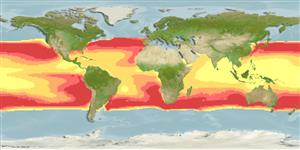Classification / Names
Common names from other countries
Main reference
Size / Weight / Age
Max length : 250 cm TL male/unsexed; (Ref. 27000); common length : 180 cm FL male/unsexed; (Ref. 168); max. published weight: 210.0 kg (Ref. 9987); max. reported age: 11 years (Ref. 30326)
Length at first maturity
Lm ?, range 100 - 125 cm
Environment
Marine; pelagic-oceanic; oceanodromous (Ref. 51243); depth range 0 - 250 m (Ref. 168), usually 0 - 50 m (Ref. 89423)
Climate / Range
Subtropical; 13°C - 29°C (Ref. 168), preferred 27°C (Ref. 107945); 45°N - 43°S, 180°W - 180°E
Distribution
Atlantic, Indian and Pacific: in tropical and subtropical waters. Absent in the Mediterranean. Highly migratory species, Annex I of the 1982 Convention on the Law of the Sea (Ref. 26139).
Countries | FAO areas | Ecosystems | Occurrences | Introductions
Short description
Dorsal
spines
(total): 13 - 14;
Dorsal
soft rays
(total): 14-15;
Anal
spines: 0;
Anal
soft rays: 14;
Vertebrae: 39. A large species, deepest near the middle of the first dorsal fin base. Lower sides and belly whitish; a lateral iridescent blue band runs along the sides in live specimens. The first dorsal fin is deep yellow, the second dorsal and anal fins are light yellow, the finlets are bright yellow edged with black.
IUCN Red List Status (Ref. 115185)
Threat to humans
Harmless
Human uses
Fisheries: highly commercial; gamefish: yes
Tools
Special reports
Download XML
Internet sources
Estimates of some properties based on models
Phylogenetic diversity index
PD50 = 0.5039 many relatives (e.g. carps) 0.5 - 2.0 few relatives (e.g. lungfishes)
Trophic Level
4.5 ±0.0 se; Based on diet studies.
Resilience
Medium, minimum population doubling time 1.4 - 4.4 years (K=0.11-0.23; tm=3; tmax=11; Fec=2 million)
Vulnerability
High vulnerability (56 of 100)
Price category
